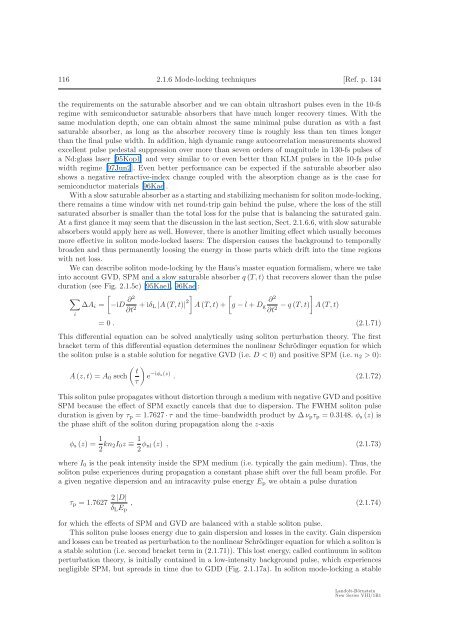2.1 Ultrafast solid-state lasers - ETH - the Keller Group
2.1 Ultrafast solid-state lasers - ETH - the Keller Group
2.1 Ultrafast solid-state lasers - ETH - the Keller Group
Create successful ePaper yourself
Turn your PDF publications into a flip-book with our unique Google optimized e-Paper software.
116 <strong>2.1</strong>.6 Mode-locking techniques [Ref. p. 134<br />
<strong>the</strong> requirements on <strong>the</strong> saturable absorber and we can obtain ultrashort pulses even in <strong>the</strong> 10-fs<br />
regime with semiconductor saturable absorbers that have much longer recovery times. With <strong>the</strong><br />
same modulation depth, one can obtain almost <strong>the</strong> same minimal pulse duration as with a fast<br />
saturable absorber, as long as <strong>the</strong> absorber recovery time is roughly less than ten times longer<br />
than <strong>the</strong> final pulse width. In addition, high dynamic range autocorrelation measurements showed<br />
excellent pulse pedestal suppression over more than seven orders of magnitude in 130-fs pulses of<br />
a Nd:glass laser [95Kop1] and very similar to or even better than KLM pulses in <strong>the</strong> 10-fs pulse<br />
width regime [97Jun2]. Even better performance can be expected if <strong>the</strong> saturable absorber also<br />
shows a negative refractive-index change coupled with <strong>the</strong> absorption change as is <strong>the</strong> case for<br />
semiconductor materials [96Kae].<br />
With a slow saturable absorber as a starting and stabilizing mechanism for soliton mode-locking,<br />
<strong>the</strong>re remains a time window with net round-trip gain behind <strong>the</strong> pulse, where <strong>the</strong> loss of <strong>the</strong> still<br />
saturated absorber is smaller than <strong>the</strong> total loss for <strong>the</strong> pulse that is balancing <strong>the</strong> saturated gain.<br />
At a first glance it may seem that <strong>the</strong> discussion in <strong>the</strong> last section, Sect. <strong>2.1</strong>.6.6, with slow saturable<br />
absorbers would apply here as well. However, <strong>the</strong>re is ano<strong>the</strong>r limiting effect which usually becomes<br />
more effective in soliton mode-locked <strong>lasers</strong>: The dispersion causes <strong>the</strong> background to temporally<br />
broaden and thus permanently loosing <strong>the</strong> energy in those parts which drift into <strong>the</strong> time regions<br />
with net loss.<br />
We can describe soliton mode-locking by <strong>the</strong> Haus’s master equation formalism, where we take<br />
into account GVD, SPM and a slow saturable absorber q (T,t) that recovers slower than <strong>the</strong> pulse<br />
duration (see Fig. <strong>2.1</strong>.5c) [95Kae1, 96Kae]:<br />
∑<br />
]<br />
ΔA i =<br />
[−iD ∂2<br />
∂t 2 +iδ L |A (T,t)| 2 ∂<br />
A (T,t)+<br />
[g 2 ]<br />
− l + D g<br />
∂t 2 − q (T,t) A (T,t)<br />
i<br />
=0. (<strong>2.1</strong>.71)<br />
This differential equation can be solved analytically using soliton perturbation <strong>the</strong>ory. The first<br />
bracket term of this differential equation determines <strong>the</strong> nonlinear Schrödinger equation for which<br />
<strong>the</strong> soliton pulse is a stable solution for negative GVD (i.e. D 0):<br />
( ) t<br />
A (z,t) =A 0 sech e −iφs(z) . (<strong>2.1</strong>.72)<br />
τ<br />
This soliton pulse propagates without distortion through a medium with negative GVD and positive<br />
SPM because <strong>the</strong> effect of SPM exactly cancels that due to dispersion. The FWHM soliton pulse<br />
duration is given by τ p =1.7627 · τ and <strong>the</strong> time–bandwidth product by Δ ν p τ p =0.3148. φ s (z) is<br />
<strong>the</strong> phase shift of <strong>the</strong> soliton during propagation along <strong>the</strong> z-axis<br />
φ s (z) = 1 2 kn 2I 0 z ≡ 1 2 φ nl (z) , (<strong>2.1</strong>.73)<br />
where I 0 is <strong>the</strong> peak intensity inside <strong>the</strong> SPM medium (i.e. typically <strong>the</strong> gain medium). Thus, <strong>the</strong><br />
soliton pulse experiences during propagation a constant phase shift over <strong>the</strong> full beam profile. For<br />
a given negative dispersion and an intracavity pulse energy E p we obtain a pulse duration<br />
τ p =1.7627 2 |D|<br />
δ L E p<br />
, (<strong>2.1</strong>.74)<br />
for which <strong>the</strong> effects of SPM and GVD are balanced with a stable soliton pulse.<br />
This soliton pulse looses energy due to gain dispersion and losses in <strong>the</strong> cavity. Gain dispersion<br />
and losses can be treated as perturbation to <strong>the</strong> nonlinear Schrödinger equation for which a soliton is<br />
a stable solution (i.e. second bracket term in (<strong>2.1</strong>.71)). This lost energy, called continuum in soliton<br />
perturbation <strong>the</strong>ory, is initially contained in a low-intensity background pulse, which experiences<br />
negligible SPM, but spreads in time due to GDD (Fig. <strong>2.1</strong>.17a). In soliton mode-locking a stable<br />
Landolt-Börnstein<br />
New Series VIII/1B1
















